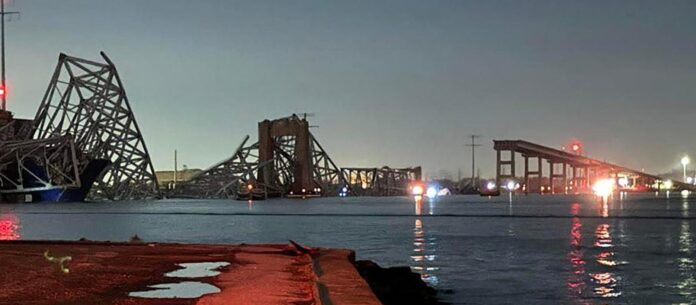When the hulking Dali cargo ship, stretching nearly 1,000 feet, violently struck the Francis Scott Key Bridge in Baltimore on March 26th, the 47-year-old bridge crumpled in under a minute. Vehicles went plunging into the icy Patapsco River below as the once-sturdy structure disintegrated into a tangled pile of steel and concrete.
The shocking collapse, which is still under investigation, has cast a glaring spotlight on the fragile state of America’s aging bridges and broader infrastructure deficiencies. While dramatic bridge failures from ship collisions are relatively rare, the Key Bridge tragedy represents an extreme example of the types of risks posed by the tens of thousands of structurally compromised bridges still operational across the United States.
“Bridges are really the backbone, the arterial network that allows our economy and society to function,” explained Kathleen Brown, a civil engineering professor at the University of Georgia. “When we have major problems like this, it’s absolutely a wake-up call about the urgent need to rehabilitate and repair our aging infrastructure before more catastrophic failures occur.”
A Crumbling Foundation
According to the latest report from the American Society of Civil Engineers (ASCE), a staggering 46,100 of the approximately 617,000 bridges across the country are currently classified as structurally deficient and in “poor” condition as of 2021. While not inherently unsafe, these bridges require significant remedial investment as their critical components show advanced deterioration.
The numbers reveal a systemic national problem. Over 178 million vehicle trips are taken across structurally deficient bridges every single day in the United States. And while steady progress has been made reducing the number of compromised bridges in recent years, the overall pace of repairs and rebuilding has slowed due to dwindling funding.
The ASCE estimates the national backlog of bridge rehabilitation projects has reached a mammoth $125 billion. Experts argue the $110 billion for roads and bridges allocated in the $1.2 trillion federal infrastructure bill passed in 2021 is a good start but hardly sufficient to address the full scope of the crisis.
“We’ve been playing this catch-up game for decades, just trying to keep pace with maintaining bridges rather than focusing on modernizing them for the increasing demands they face,” said Brown. “Catastrophic failures will keep happening if we don’t get ahead of the problem.”
Escalating Risks
Beyond simply aging, bridges across America confront an array of intensifying threats that accelerate degradation. The ASCE found nearly 21,000 bridges are susceptible to damage from extreme weather events like hurricanes, floods, and earthquakes that can undermine their structural foundations.
Rising temperatures from climate change can cause bridge materials to expand and contract more frequently, generating new cracks and fissures over time. Heavier trucks regularly crossing bridges, sometimes exceeding 40 tons when originally designed for lower weight limits, add much greater stress that can lead to fatigue cracking and shorter lifespans.
Then there’s the issue of larger commercial ships, which have expanded dramatically in size over the last few decades to accommodate growing global trade volumes. The average cargo vessel operating today is multiple times larger than those around when many of America’s bridges were first constructed half a century ago or more.
“Bridges like the Key Bridge were never intended to withstand collisions from these modern behemoths weighing over 100,000 tons,” said Rick Dill, a retired bridge inspector in Maryland. “It was really only a matter of time before we saw a major failure at one of these older crossings that wasn’t adequately fortified against the shipping traffic.”
A Perilous Lack of Safeguards
Beyond their age and deteriorating condition, officials have highlighted another alarming vulnerability – around 17,000 U.S. bridges are currently classified as “fracture critical.” This means that if struck hard enough by a ship or other force at just the right location, a failure of a single, vital component could lead to a catastrophic collapse of the entire bridge.
The Key Bridge, which spanned the busy northwest branch of the Patapsco River, was identified as fracture critical lacking engineered redundancies to prevent total failure in the event of a collision. Maritime experts warn that as ships continue increasing in scale over the coming decades, the potential for more bridge disasters will only grow without significant upgrades and new protection systems.
“Retrofitting fracture critical bridges with additional support columns and crash barriers is absolutely essential as these cargo ships just get larger and larger,” advised Ananth Prasad, president of the Florida Transportation Builders’ Association. “It’s ultimately the only way to prevent these rare but devastating collisions from becoming even more frequent occurrences in the future.”
A Wake-Up Call
While the chaotic scenes from Baltimore showcased an extreme case, the Key Bridge debacle reflects the much broader crisis simmering across the country. Crumbling road, rail, and utility infrastructure of all kinds inhibits economic productivity, public safety, and America’s overall competitiveness.
The American Society of Civil Engineers has estimated that deficient infrastructure systems cost the U.S. economy trillions in lost business, higher household costs, and other drains. Making the necessary investments in modern, resilient infrastructure would actually save money in the long run by enhancing efficiency, sustainability, and quality of life.
“The Key Bridge collapse was definitely a wake-up call, but we need to recognize that the costs and risks keep escalating every year we delay in tackling this nationwide infrastructure overhaul head-on,” said Kathleen Brown. “Funding at all levels of government needs to be rapidly increased to modernize our bridges, roads, and utilities for the 21st century – plain and simple. The status quo is no longer tenable.”
As investigations into exactly what caused the Key Bridge to fail continue, the pressure to finally confront America’s protracted infrastructure woes has perhaps never been greater. Experts insist that while daunting, a robust, proactive response is long overdue. If not, the unthinkable catastrophes witnessed in Baltimore could become just the beginning of even more frequent and costly disasters plaguing communities nationwide.





















